Have you been suffering from persistent pain, tingling, or numbness in your hand and arm? It’s possible that you may be dealing with an ulnar nerve injury, a condition that can significantly impact your daily life. Imagine struggling to hold objects, experiencing discomfort when using your hand, or even noticing weakness in your grip. Fortunately, there’s hope for relief right here at the Sydney Orthopaedic Surgeon Clinic.
Dr Stuart Kirkham, our highly skilled and knowledgeable orthopaedic surgeon with over 25 years of experience, leads our dedicated team. He specialises in the treatment of upper limb injuries and has helped countless patients regain their hand function and alleviate the discomfort associated with ulnar nerve injuries. With his expertise and commitment to quality care, you can trust that you’re in capable hands.
We understand how important it is to have a pain-free and fully functional hand. Don’t let an ulnar nerve injury hold you back from enjoying life to the fullest. Reach out to us today to schedule a consultation with Dr Kirkham. Together, we’ll work towards finding the best solution tailored to your unique needs, so you can get back to doing the things you love with ease. Your journey to recovery begins here.
Anatomy
The ulnar nerve, a vital component of our upper limb’s intricate anatomy, plays a pivotal role in ensuring the proper functioning of our hands and arms. Nestled behind the medial epicondyle of the distal humerus at the elbow, it’s often referred to as “the funny bone.” Yet, this so-called funny bone is no laughing matter when irritated, as it can create sensations that are far from amusing, particularly in the little and ring fingers.
This nerve’s purpose is to transmit signals essential for muscle control and sensation. It intricately connects with the various parts of our hand and arm, orchestrating their harmonious function. The ulnar nerve ventures further, branching out into the hand, sending signals to the muscles responsible for fine motor movements and sensory receptors that allow us to perceive touch and temperature.
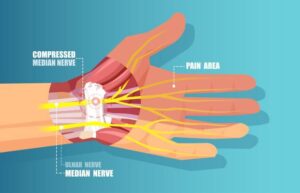
As it travels through the arm and into the hand, the ulnar nerve also weaves around an intricate network of tendons, ligaments, and muscles. Its mission is to ensure that your hand moves with precision and that you can feel the world around you. When this nerve encounters irritation, it can disrupt the harmony of signals it conducts, leading to sensory disturbances in the hand.
Much like the rotator cuff’s critical role in shoulder function, the ulnar nerve’s health and function are paramount for optimal hand and arm mobility. Understanding its location and purpose underscores the importance of prompt attention and care when facing ulnar nerve injuries. Don’t let an ulnar nerve injury hold you back any longer. Get in touch with Dr Kirkham to discuss the potential impact an injury may have on the rest of your anatomy and work towards finding relief from your pain.
Causes and Risk Factors
Ulnar nerve injuries can arise from a variety of sources, each with its own unique set of challenges. Understanding how these injuries can occur is the first step in mitigating their impact on your hand and arm function. Trauma, whether sudden or repetitive, is often a cause of these injuries. A direct blow to the elbow or prolonged pressure on the nerve can lead to irritation or damage, triggering symptoms.
Overuse and repetitive strain can also cause these injuries. Occupations or activities that involve repetitive gripping, like assembly line work or extensive computer use, can subject the ulnar nerve to constant stress, increasing the likelihood of injury over time. Additionally, anatomical variations in the elbow’s structure can predispose individuals to ulnar nerve issues, making awareness of these factors crucial.

Risk factors further contribute to the susceptibility of ulnar nerve injuries. Conditions such as diabetes, rheumatoid arthritis, and obesity can heighten the risk, as they may lead to nerve compression or compromise overall nerve health. Moreover, lifestyle choices and habits, like smoking and excessive alcohol consumption, can exacerbate the risk, emphasising the importance of a holistic approach to maintaining hand and arm health.
Regardless of the cause or risk factors, Dr Kirkham is well equipped with the expertise necessary to diagnose and treat ulnar nerve injuries effectively. With his guidance, you can rest assured that your condition will be accurately assessed, and an individualised plan will be tailored to your specific needs. By addressing both the underlying causes and risk factors, Dr Kirkham ensures that you receive comprehensive care to alleviate symptoms and regain optimal hand and arm function.
Symptoms and Identification
Recognising the symptoms of ulnar nerve injuries is crucial for timely intervention. These injuries can manifest in many different ways, and they often cause discomfort and functional limitations. Symptoms may include tingling or numbness in the ring and little fingers, which are often the earliest signs of ulnar nerve irritation. You might also notice weakness in your hand, making it harder than usual for you to grip or manipulate objects. In more advanced cases, pain along the inner side of the elbow may become a constant issue.
Distinguishing between ulnar nerve entrapment, ulnar nerve pain, and ulnar nerve compression is essential for accurate diagnosis. Ulnar nerve entrapment typically involves the nerve being pinched or compressed at the elbow, leading to symptoms like numbness and tingling in the hand and fingers.
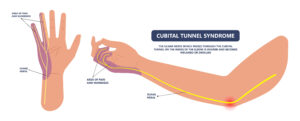
Ulnar nerve pain, on the other hand, might be the result of irritation along the nerve’s pathway, often causing discomfort or aching sensations in the arm, elbow, or hand. Ulnar nerve compression is a more severe form of entrapment, where prolonged pressure on the nerve can lead to muscle weakness and even muscle wasting in the hand, accompanied by significant pain.
If you’ve been experiencing any of these symptoms, seeking consultation with a specialist is highly advisable. Dr Kirkham at the Sydney Orthopaedic Surgeon Clinic has provided expert guidance to many patients and can accurately diagnose ulnar nerve injuries and to ensure they are provided with a personalised treatment plan. Don’t let these symptoms hinder your daily life; let Dr Kirkham guide you towards effective solutions, restoring your hand and arm function and enhancing your overall quality of life.
Diagnosis and Imaging
Dr Kirkham’s thorough process of diagnosing ulnar nerve injuries begins with a comprehensive assessment to understand your medical history, symptoms, and any contributing factors. This helps Dr Kirkham refine his advice and guides his initial evaluation of your injury, ensuring he develops a thorough understanding of your current condition. To confirm the diagnosis and assess the extent of the injury, he uses a range of diagnostic tools and techniques to verify his initial thoughts.
Imaging plays a pivotal role in the diagnostic process. While X-rays do not directly provide a clear visual of the ulnar nerve, they are crucial in ensuring no other potential issues are contributing to the condition, such as loose bodies within the elbow. Magnetic Resonance Imaging (MRI) is also a valuable tool, offering detailed images of soft tissues and nerve structures. Nerve conduction studies are also conducted to diagnose these conditions because ulnar nerve compression (or friction or traction) is intermittent rather than static. These studies can provide insights into how well the ulnar nerve is transmitting signals, helping Dr Kirkham pinpoint the location and severity of the injury.
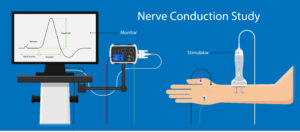
Timely diagnosis is important for achieving better treatment outcomes. Early intervention can prevent the progression of symptoms and minimise long-term complications. Dr Kirkham’s focus on early diagnosis aligns with the understanding that prompt treatment tailored to your specific condition can enhance your chances of regaining full hand and arm function.
If you suspect you may be experiencing symptoms related to ulnar nerve injuries or have risk factors that raise concern, don’t hesitate to seek expert medical advice. Dr Kirkham at the Sydney Orthopaedic Surgeon Clinic is committed to providing each of his patients the specialised care and attention they deserve. With a precise diagnosis as the foundation, you can create a clear path to recovery and reclaim the quality of life you deserve. Reach out to our friendly team today to schedule a consultation and take the first step towards addressing your ulnar nerve concerns.
Treatment Options
When it comes to addressing ulnar nerve injuries, a range of treatment options are available that each cater to the severity of the condition and the needs of the individual patient. The initial approach often involves conservative treatments aimed at alleviating symptoms and promoting healing. Physical therapy plays a pivotal role in this phase, with specialised exercises and techniques designed to improve the ulnar nerve’s function and reduce compression. Medications, such as non-steroidal anti-inflammatory drugs (NSAIDs), may be prescribed to manage pain and inflammation.
In cases where more conservative treatments don’t provide sufficient relief or when the ulnar nerve injury is more severe, surgical intervention may be necessary. Dr Kirkham is well-versed in these procedures and can offer expert guidance. Surgical options may include decompression, where the pressure on the nerve is alleviated, or an ulnar nerve transposition, where the nerve is repositioned to reduce irritation. Success rates vary depending on the specific procedure and the individual patient, but Dr Kirkham’s extensive training, study and expertise ensures that you receive the best possible outcome.
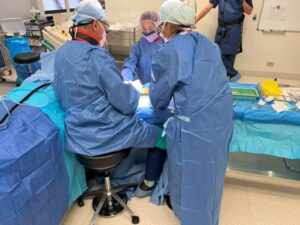
Rehabilitation is a crucial aspect of the treatment journey. Post-treatment, whether through conservative measures or surgery, a tailored rehabilitation program is essential to regain strength, mobility, and functionality. Dr Kirkham and his team provide guidance and support throughout this phase, offering exercises and recommendations to promote optimal recovery.
Ultimately, the choice of treatment depends on the nature and severity of the ulnar nerve injury. Dr Kirkham’s comprehensive approach ensures that you receive personalised care and a treatment plan tailored to your unique circumstances. Whether through conservative measures or surgical intervention, followed by diligent rehabilitation, our goal is to help you regain the full use of your hand and arm, enabling you to get back to your daily activities with confidence and comfort.
Prevention and Aftercare
Preventing ulnar nerve injuries usually requires a proactive approach to hand and arm health. Engaging in specific exercises that strengthen the forearm and hand muscles can help maintain proper nerve function and reduce the risk of injury. Simple movements like wrist curls and finger stretches can go a long way in promoting hand health.
Equally important is maintaining proper ergonomics in your daily activities. Whether at work or during leisurely activities, paying attention to how you position your hands and arms can make a significant difference. Adjusting the height of your computer keyboard, using ergonomic tools, and taking regular breaks to stretch and relax your hands can minimise stress on the ulnar nerve.

Aftercare following treatment or surgery is a critical phase in the recovery journey. Dr Kirkham and his team provide guidance on post-treatment care to ensure the best possible outcome. This may include specific exercises tailored to your condition, wound care instructions if surgery was involved, and pain management strategies. It’s essential to follow these recommendations carefully to promote healing and prevent long-term complications.
By incorporating these preventive measures and adhering to aftercare guidelines, you can reduce the risk of ulnar nerve injuries and enhance your hand and arm health. Dr. Kirkham’s commitment to holistic care ensures that you receive the support and information you need to maintain optimal hand and arm function, empowering you to lead a comfortable and active life free of ulnar nerve pain.
The Recovery Process
The recovery process following the initial treatment for an ulnar nerve injury can depend on the chosen approach, whether conservative or surgical. It’s essential for patients to have a clear understanding of what to expect during this crucial phase.
Post-treatment, patients can expect to face an initial period of rest and restricted activity to allow the ulnar nerve to heal and to allow any inflammation to subside. This period of immobilisation is often vital to a successful recovery because it provides the nerve with an opportunity to recuperate without any stress on it.
The timeline of this recovery differs between conservative and surgical treatments. More conservative measures may require less time for the initial recovery, and it often involves physical therapy and targeted exercises to help the patient regain strength and mobility. Surgical interventions however may require a longer recovery period due to the more invasive nature of the procedures.

Adhering to recovery protocols is important in ensuring a smooth healing process is encountered, allowing the patient to achieve the best possible outcome. Patients are encouraged to closely follow the guidance provided by Dr Kirkham, and this may include attending follow-up appointments, participating in rehabilitation exercises, and avoiding strenuous activities that may exacerbate the condition during the healing phase.
While the recovery process may require patience and dedication, Dr Kirkham’s expertise and support ensure that you receive comprehensive care and guidance throughout. By understanding what to expect, adhering to recovery protocols, and seeking timely medical advice, you can look forward to regaining full hand and arm functionality and resuming your normal daily activities with confidence.
Possible Complications
Understanding the potential complications associated with ulnar nerve injuries is crucial for informed decision-making and ongoing care. After surgical interventions, there is a possibility of complications, albeit relatively rare. These can include infection, scarring, or adverse reactions to anaesthesia, all of which are minimal risks associated with all surgical procedures. It’s important to note that Dr Kirkham’s extensive experience minimises these risks. Dr Kirkham adheres to strict sterilisation standards, and he always takes great care to operate delicately and with the greatest attention to detail.
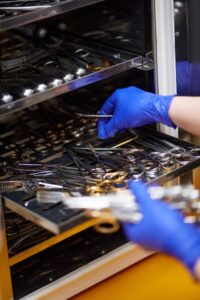
Leaving ulnar nerve injuries untreated can lead to more severe complications. Over time, untreated nerve compression or damage can result in muscle weakness and atrophy in the hand, impairing functionality. Chronic pain and sensory disturbances may become more pronounced, negatively impacting your quality of life. Early identification of complications is essential for timely intervention. Dr Kirkham and his team provide clear instructions on what to watch for and when to seek medical attention. Symptoms such as increasing pain, persistent numbness or tingling, and unexpected changes in sensation should never be ignored.
To minimise the risk of complications, it’s crucial to closely follow all medical advice that Dr Kirkham provides. Whether it’s adhering to post-operative care instructions or attending follow-up appointments, compliance is key. By staying actively engaged in your treatment plan and promptly addressing any concerns or changes in your condition, you can significantly reduce the likelihood of complications and ensure the best possible outcome.
 Dr. Stuart Kirkham’s dedication to patient care encompasses the prevention and management of complications. With his guidance and expertise, you can trust that your ulnar nerve injury treatment journey is in capable hands, focused on maximising your hand and arm function while minimising potential risks.
Dr. Stuart Kirkham’s dedication to patient care encompasses the prevention and management of complications. With his guidance and expertise, you can trust that your ulnar nerve injury treatment journey is in capable hands, focused on maximising your hand and arm function while minimising potential risks.
Are You Concerned About Ulnar Nerve Injuries?
If you’ve been experiencing symptoms like persistent tingling, numbness, or weakness in your hand and arm, we understand the concern and discomfort you may be facing. Ulnar nerve injuries can be distressing, but by seeking timely consultation with Dr Kirkham, you’ll be taking an important first step towards regaining your hand and arm function.
When you entrust Dr Kirkham with managing your ulnar nerve injury, you can rest assured that you’re in the most capable hands. As a highly skilled orthopaedic surgeon with over 25 years of experience and a vast portfolio of research and study, Dr Kirkham is dedicated to providing quality care tailored to the unique needs of every one of his patients. Dr. Kirkham’s expertise in diagnosing and treating ulnar nerve injuries also ensures that you receive the best possible care and the most effective solutions for your condition.
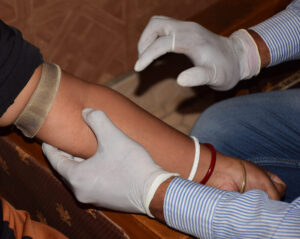
Your journey to recovery begins with a simple action: reaching out for a location at one of Dr Kirkham’s conveniently located clinics across Sydney. Don’t let the uncertainty of ulnar nerve injuries hold you back from living life to the fullest. Contact our friendly team today to schedule a consultation with Dr Kirkham. He is always available to listen to your concerns, provide expert guidance, and help you take the necessary steps towards regaining control of your hand and arm function.
Remember, the sooner you arrange a consultation, the earlier Dr Kirkham can begin addressing your symptoms and developing a personalised treatment plan that relieves your pain and discomfort. Don’t hesitate; take that important step today towards a brighter, more comfortable tomorrow.
FAQs
- What should I expect after ulnar nerve transposition surgery?
After ulnar nerve transposition surgery, it’s common to experience some discomfort and swelling at the surgical site. To manage this, you’ll likely be advised to keep your arm elevated when resting and to use ice packs as directed. Sleeping can be challenging initially, but you’ll be given guidance on positioning your arm to minimise stress on the healing nerve. Ulnar nerve pain may persist for a while, but it should gradually improve over time. Healing times vary, but you can expect several months for the nerve to fully recover. The timing for returning to work depends on your job’s physical demands, but Dr Kirkham will provide personalised advice. Pain levels should decrease as healing progresses, but it’s essential to follow your post-operative care plan and attend follow-up appointments for optimal recovery.
- What are the typical symptoms of ulnar nerve injuries?
Ulnar nerve injuries can manifest with a range of symptoms. These may include tingling or numbness in the ring and little fingers, often accompanied by weakness in the hand. Some individuals may experience pain along the inner side of the elbow, which can radiate down the arm. Additionally, you might notice difficulty with fine motor skills, like gripping objects or manipulating small items. It’s important to remember that the severity and combination of these symptoms can vary from person to person. If you suspect you may have ulnar nerve issues, seeking medical evaluation is crucial to determine the appropriate treatment.
- How can I prevent ulnar nerve injuries in the workplace?
Preventing ulnar nerve injuries in the workplace begins with maintaining proper ergonomics. Ensure that your workspace is set up to minimise stress on your hands and arms. Use ergonomic tools and equipment, take regular breaks to stretch, and practice good hand health habits. If your job involves repetitive gripping or manual labour, incorporate hand and forearm strengthening exercises into your routine. Moreover, if you spend long hours typing or using a computer, consider using wrist supports to maintain proper hand alignment. These proactive measures can significantly reduce the risk of ulnar nerve injuries in a workplace setting.
- Can ulnar nerve injuries be caused by sports or recreational activities?
Yes, ulnar nerve injuries can occur as a result of certain sports or recreational activities. Activities that involve repetitive wrist movements, such as racquet sports or weightlifting, can subject the ulnar nerve to continuous stress and potential irritation. Additionally, contact sports or activities that pose a risk of direct impact to the elbow may increase the likelihood of trauma-related ulnar nerve injuries. It’s crucial to be aware of the demands these activities place on your arms and hands and take precautions, such as using proper techniques and protective gear, to minimise the risk of injury.
- Are there any dietary factors that can affect ulnar nerve health?
While diet may not be a direct cause of ulnar nerve injuries, certain nutritional factors can influence nerve health in general. Adequate intake of vitamins B6 and B12, as well as essential minerals like magnesium, is essential for maintaining healthy nerves. A balanced diet that includes sources of these nutrients, such as lean meats, fish, whole grains, and leafy greens, can support overall nerve function. Additionally, staying hydrated is crucial, as dehydration can exacerbate nerve-related symptoms. However, it’s essential to note that dietary factors are just one aspect of nerve health, and they should complement a comprehensive approach to preventing and managing ulnar nerve injuries.
References
- OrthoInfo (Ulnar Nerve Entrapment at the Elbow (Cubital Tunnel Syndrome))
- Cleveland Clinic (Ulnar Nerve Entrapment)
- John Hopkins Medicine (Ulnar Nerve Entrapment)
- Mount Sinai (Ulnar Nerve Dysfunction)


